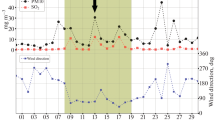Abstract
The results of ground-based and satellite spectroscopic measurements of the tropospheric NO2 content near St. Petersburg in January–March 2006 are presented. It is shown that the increased concentrations of NO2 observed in St. Petersburg and its vicinities in this period were caused by NO2 accumulation due to unfavorable weather conditions, which is confirmed by an analysis of meteorological data and the results of a numerical simulation of the dispersion of urban air pollutants. Data from satellite and ground-based measurements agree with each other satisfactorily (a correlation coefficient of 0.5) and with model calculations of tropospheric NO2 conducted for the coordinates of a station of ground-based measurements (a correlation coefficient of 0.6). The HYSPLIT dispersion model also made it possible to estimate the scale of the NO2 spatial-temporal variability in the near-surface layer in the vicinities of St. Petersburg.
Similar content being viewed by others
References
L. F. Goldovskaya, Environmental Chemistry (Mir, Moscow, 2005) [in Russian].
V. B. Milyaev, N. M. Golovina, and A. N. Selyakova, “Analysis of Pollutant Emissions from Point and Mobile Sources on the Territory of the Town of St. Petersburg and Leningrad Region,” in Problems in Atmospheric Air Protection, Collection of Scientific Works (Scientific Research Institute “Atmosfera”, St. Petersburg, 2010) [in Russian].
D. V. Ionov and Yu. M. Timofeev, “Regional Space Monitoring of Nitrogen Dioxide in the Troposphere,” Izv., Atmos. Ocean. Phys. 45(4), 434–443 (2009).
A. Richter, J. P. Burrows, H. Nuss, et al., “Increase in Tropospheric Nitrogen Dioxide over China Observed from Space,” Nature 437, 129–132 (2005). doi: 10.1038/nature04092
R. J. van der A, H. Eskes, K. F. Boersma, et al., “Trends, Seasonal Variability and Dominant NOx Source Derived from a Ten Year Record of NO2 Measured from Space,” J. Geophys. Res. 113, D04302 (2008). doi: 10.1029/2007JD009021
I. B. Konovalov, “Regional Differences in the Decadal Variations of Atmospheric Emissions of Nitrogen Oxides in the European Part of Russia: Results of Inverse Modeling Based on Satellite Data,” Dokl. Earth Sci. 417A(9), 1424–1427 (2007).
D. V. Ionov, “Tropospheric NO2 Trend over St. Petersburg (Russia) as Measured from Space,” Russ. J. Earth Sci. 11, ES4004 (2010). doi: 10.2205/2010ES000437
A. V. Poberovskii, A. V. Shashkin, D. V. Ionov, et al., “NO2 Content Variations near St. Petersburg as Inferred from Ground-Based and Satellite Measurements of Scattered Solar Radiation,” Izv., Atmos. Ocean. Phys. 43(4), 505–513 (2007).
Russia’s Weather Server. http://meteo.infospace.ru/
European Centre for Medium-Range Weather Forecasts, http://www.ecmwf.int
University of Wyoming, Upper Air Data, Soundings. http://weather.uwyo.edu/upperair
St. Petersburg Committee for Nature Use Environmental Protection and Ecological Safety. http://www.infoeco.ru
Health Standards for Maximum Allowable Concentrations of Pollutants in the Atmospheric Air of Populated Places. GN 2.1.6.1338-03. Regulation by Ministry of Health of Russian Federation (30.05.2003).
P. F. Levelt, E. Helserath, G. W. Leppelmeier, et al., “Science Objectives of the Ozone Monitoring Instrument,” IEEE Trans. Geosci. Remote Sens. 44(5), 1199–1208 (2006).
Network for the Detection of Atmospheric Composition Change. http://www.ndacc.org
A. S. Elokhov and A. N. Gruzdev, “Nitrogen Dioxide Column Content and Vertical Profile Measurements at the Zvenigorod Research Station,” Izv., Atmos. Ocean. Phys. 36(6), 763–777 (2000).
V. V. Rozanov, M. Buchwitz, K.-U. Eichmann, et al., “SCIATRAN—A New Radiative Transfer Model for Geophysical Applications in the 240–2400 nm Spectral Region: The Pseudo-Spherical Version,” Adv. Space Res. 29(11), 1831–1835 (2002).
U.S. Standard Atmosphere. http://modelweb.gsfc.nasa.gov/atmos/us_standard.html
L. Denis, H. K. Roscoe, M. P. Chipperfield, et al., “A New Software Suite for NO2 Vertical Profile Retrieval from Ground-Based Zenith-Sky Spectrometers,” J. Quant. Spectrosc. Radiat. Transfer 92(3), 321–333 (2005).
K. S. Law and J. A. Pyle, “Modeling Trace Gas Budgets in the Troposphere. 1. Ozone and Odd Nitrogen,” J. Geophys. Res. 98, 18377–18400 (1993).
J.-C. Lambert, J. Granville, M. van Roozendael, et al., “Global Behavior of Atmospheric NO2 as Derived from the Integrated Use of Satellite, Ground-Based Network and Balloon Observations,” in Atmospheric Ozone. Proceedings of the 19th Quadrennial Ozone Symposium, Sapporo, Hokkaido, Japan, July 3–8, 2000 (NASDA, Sapporo, 2000), pp. 201–202.
E. L. Fleming, S. Chandra, J. J. Barnett, et al., “Zonal Mean Temperature, Pressure, Zonal Wind, and Geopotential Height as Function of Latitude,” Adv. Space Res. 10(12), 11–59 (1990).
V. A. Ivanov and O. V. Postylyakov, “Evaluation of the Integral Content of NO2 in the Atmospheric Boundary Layer from Zenith-Scattered Solar Radiation Observation Data,” Opt. Atmos. 23(6), 471–474 (2010).
R. R. Draxler and G. D. Hess, “An Overview of the HYSPLIT-4 Modelling System for Trajectories, Dispersion and Deposition,” Aust. Meteorol. Mag. 47(4), 295–308 (1998).
Yandex Analytical Center “Yandex.TrafficJam.” http://www.yaprobki.ru/statistics
M. L. Wesely, “Parameterization of Surface Resistances to Gaseous Dry Deposition in Regional-Scale Numerical Models,” Atmos. Environ. 23(6), 1293–1304 (1989).
K. F. Boersma, H. J. Eskes, and E. J. Brinksma, “Error Analysis for Tropospheric NO2 Retrieval from Space,” J. Geophys. Res. 109, D04311 (2004). doi: 10.1029/2003JD003962
A. N. Gruzdev and A. S. Elokhov, “Validating NO2 Measurements in the Vertical Atmospheric Column with the OMI Instrument aboard the EOS Aura Satellite against Ground-Based Measurements at the Zvenigorod Scientific Station,” Izv., Atmos. Ocean. Phys. 45(4), 444–455 (2009).
NCEP Global Data Assimilation System. http://ready.arl.noaa.gov/gdas1.php
NCEP/NCAR Global Reanalysis. http://ready.arl.noaa.gov/gbl_reanalysis.php
A. V. Makarova, A. V. Rakitin, D. V. Ionov, et al., “Analysis of Variability of the CO, NO2, and O3 Contents in the Troposphere near St. Petersburg,” Izv., Atmos. Ocean. Phys. 47(4), 468–479 (2011).
Author information
Authors and Affiliations
Corresponding author
Additional information
Original Russian Text © D.V. Ionov, A.V. Poberovskii, 2012, published in Izvestiya AN. Fizika Atmosfery i Okeana, 2012, Vol. 48, No. 4, pp. 422–433.
Rights and permissions
About this article
Cite this article
Ionov, D.V., Poberovskii, A.V. Nitrogen dioxide in the air basin of St. Petersburg: Remote measurements and numerical simulation. Izv. Atmos. Ocean. Phys. 48, 373–383 (2012). https://doi.org/10.1134/S0001433812040093
Received:
Accepted:
Published:
Issue Date:
DOI: https://doi.org/10.1134/S0001433812040093




